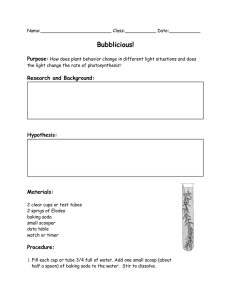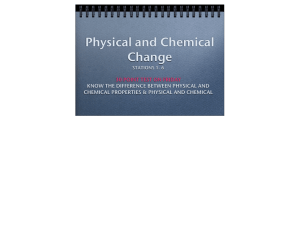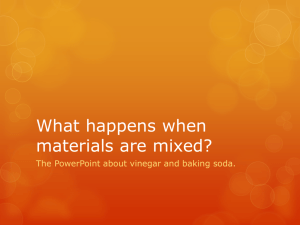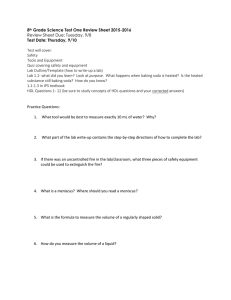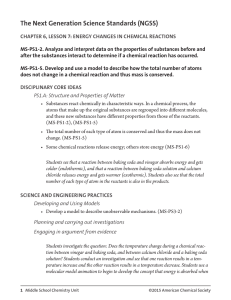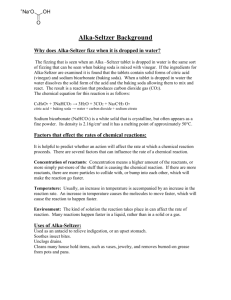Document 14894052
advertisement
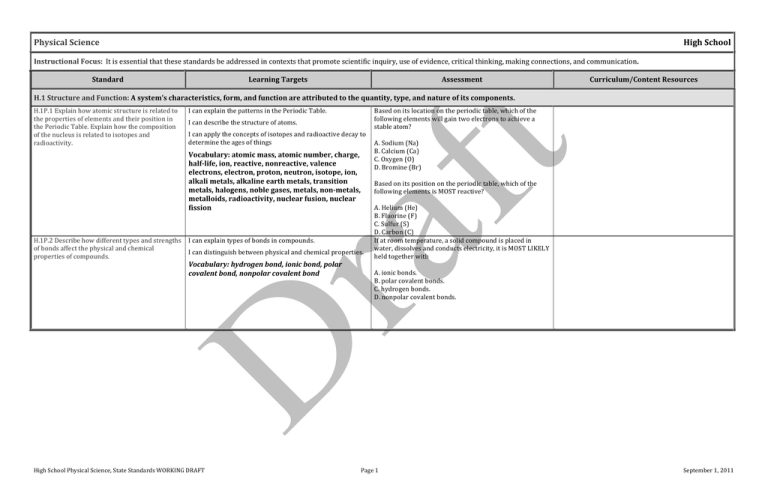
Physical Science High School Instructional Focus: It is essential that these standards be addressed in contexts that promote scientific inquiry, use of evidence, critical thinking, making connections, and communication. Standard Learning Targets Assessment Curriculum/Content Resources H.1 Structure and Function: A system’s characteristics, form, and function are attributed to the quantity, type, and nature of its components. H.1P.1 Explain how atomic structure is related to the properties of elements and their position in the Periodic Table. Explain how the composition of the nucleus is related to isotopes and radioactivity. I can explain the patterns in the Periodic Table. H.1P.2 Describe how different types and strengths of bonds affect the physical and chemical properties of compounds. I can explain types of bonds in compounds. I can describe the structure of atoms. I can apply the concepts of isotopes and radioactive decay to determine the ages of things Vocabulary: atomic mass, atomic number, charge, half-­‐life, ion, reactive, nonreactive, valence electrons, electron, proton, neutron, isotope, ion, alkali metals, alkaline earth metals, transition metals, halogens, noble gases, metals, non-­‐metals, metalloids, radioactivity, nuclear fusion, nuclear fission I can distinguish between physical and chemical properties. Vocabulary: hydrogen bond, ionic bond, polar covalent bond, nonpolar covalent bond Based on its location on the periodic table, which of the following elements will gain two electrons to achieve a stable atom? A. Sodium (Na) B. Calcium (Ca) C. Oxygen (O) D. Bromine (Br) Based on its position on the periodic table, which of the following elements is MOST reactive? A. Helium (He) B. Fluorine (F) C. Sulfur (S) D. Carbon (C) If at room temperature, a solid compound is placed in water, dissolves and conducts electricity, it is MOST LIKELY held together with A. ionic bonds. B. polar covalent bonds. C. hydrogen bonds. D. nonpolar covalent bonds. High School Physical Science, State Standards WORKING DRAFT Page 1 September 1, 2011 Standard Learning Targets Assessment Curriculum/Content Resources H.2 Interaction and Change: The components in a system can interact in dynamic ways that may result in change. In systems, changes occur with a flow of energy and/or transfer of matter. H.2P.1 Explain how chemical reactions result from the making and breaking of bonds in a process that absorbs or releases energy. Explain how different factors can affect the rate of a chemical reaction. I can explain how energy changes in a reaction (exothermic and endothermic). Sam and Jordan are studying the reaction between vinegar and baking soda. They already know that when vinegar and baking soda are mixed a vigorous reaction produces a lot of I can identify factors that can affect the rate of a reaction. bubbles and that the baking soda seems to disappear Vocabulary: activation energy, combustion, dilution, during the reaction. During a class discussion, the students figured out that the equation for the reaction is: enzyme, exothermic, endothermic, synthesis, decomposition, combustion, catalysts, concentration, Vinegar + Baking Soda → Carbon Dioxide + Water + Sodium Acetate pressure, surface area CH3COOH + NaHCO3 → CO2 + H2O + Na(CH3COO) Sam and Jordan measure 50 mL of vinegar and pour it into a flask. Then they weigh out 10 g of baking soda. Sam starts the stopwatch when Jordan dumps the baking soda into the flask, then Jordan gently swirls the flask while Sam watches to see when the last bubbles are given off by the reaction. They have determined that the reaction takes 30 sec. under these conditions. If Sam adds 5 g of baking soda, rather than the 10 g that was used in the first trial, the change in the experiment will A. decrease the reaction time, and the bubbles will stop in less than 30 seconds. B. increase the reaction time and the bubbles will continue for more than 30 seconds. C. have no effect on the speed of the reaction and the bubbles will stop in 30 seconds. D. be impossible to be predicted, given this information. H.2P.2 Explain how physical and chemical changes demonstrate the law of conservation of mass. I can distinguish between physical and chemical changes. I can explain the law of conservation of matter. Vocabulary: emission, evaporation, condensation, melting, freezing, sublimation, boiling, dissolving, solvent, solute, solution, chemical reaction High School Physical Science, State Standards WORKING DRAFT Page 2 September 1, 2011 Standard H.2P.3 Describe the interactions of energy and matter including the law of conservation of energy. H.2P.4 Apply the laws of motion and gravitation to describe the interaction of forces acting on an object and the resultant motion. Learning Targets I can describe how energy and matter interact. Assessment The diagrams below show a man swinging a golf club. Curriculum/Content Resources I can explain how energy and matter cannot be created or destroyed. Vocabulary: amplitude, entropy, frequency, hertz, thermal equilibrium, transformation, wavelength, kinetic energy, heat energy, thermal equilibrium, magnetic field, sound energy, seismic energy, electrical energy, mechanical energy, potential energy, gravitational energy, elastic energy, chemical energy, radiant energy, electromagnetic energy I can explain laws of motion and gravitation. I can apply laws of motion and gravitation. Vocabulary: acceleration, momentum, Newton, inertia, vector, force, gravitation, motion The kinetic energy of the golf club at point Y is more than the potential energy of the club at point X. Which of the following statements best explains why this fact does not violate the law of conservation of energy? A. Gravity is constant from point X to point Y. B. Air resistance is greater at point Y than at point X. C. Acceleration due to gravity is greater at point Y than at point X. D. Energy is added A surfer paddles out from shore in search of the perfect wave. The surfer has a weight of 500 N and the surfboard weighs 100 N. As the surf gets rougher, the surfer estimates that she is bobbing up and down once every two seconds. What is the frequency of the water waves that are passing her? A. 0.5 Hertz B. 1.0 Hertz C. 2.0 Hertz D. 3.0 Hertz The force exerted on a cart is constant. On a frictionless surface, if the cart's mass is increased, the acceleration will A. increase only. B. decrease only. C. increase, then decrease. D. decrease, then increase. A surfer paddles out from shore in search of the perfect wave. The surfer has a weight of 500 N and the surfboard weighs 100 N. When the surfer is on a surfboard floating on calm water, what is the buoyant force pushing up on the board? A. 100 Newtons B. 400 Newtons C. 500 Newtons D. 600 Newtons High School Physical Science, State Standards WORKING DRAFT Page 3 September 1, 2011
